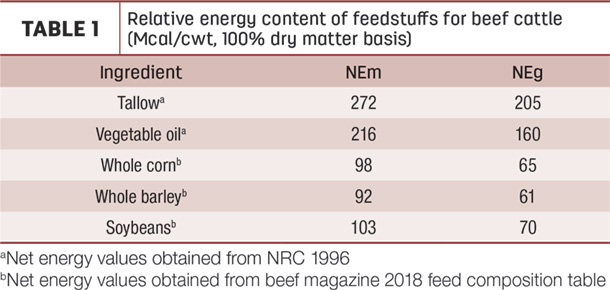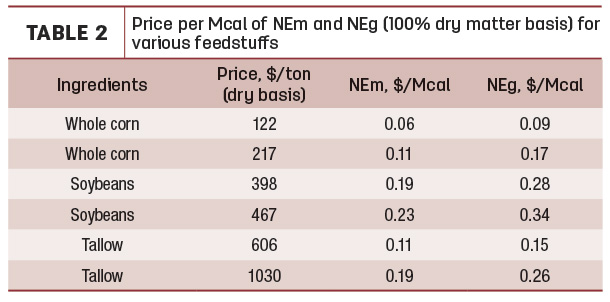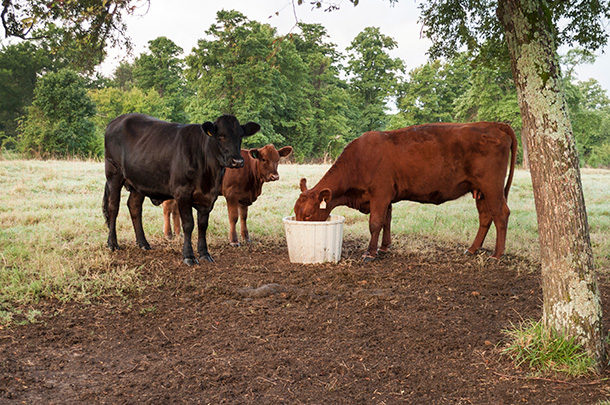Beef cattle have been supplemented fat for years. The primary reason being that supplemental fats are a concentrated source of energy containing nearly two to three times the net energy of cereal grains.
Table 1 contains examples of the net energy value of tallow and vegetable oil compared to different sources of cereal grains and soybeans.
Fat can also affect a variety of physiological processes that improve performance. When priced appropriately, supplemental fats can be an effective means to increase dietary energy density.
Fat sources and metabolism
A variety of fat sources exist that can be included in the diets of beef cattle. These include fats originating from either oilseeds and grains, rendered animal byproducts, or yellow grease from the food service industry. Once consumed, fats go through a structural change in the rumen called biohydrogenation. This change can lead to an increase in the amount of propionic acid, one of the major volatile fatty acids produced and a precursor to glucose. Increased propionic acid production provides more energy to the animal. However, the exact advantages of fat supplementation are difficult to ascertain due to differences in fatty acid makeup and extent of biohydrogenation between sources.

Supplementing fat to feedlot cattle
Including supplemental fat in the diet of finishing cattle is known to improve feed efficiency, but performance response is quite variable. A few factors need to be considered when deciding to use fat as an energy source in finishing diets. Type of fat must be taken into consideration as various types can affect the net energy of the diet differently, resulting in some of the variation in animal performance.
In addition to type, quality of fat can affect performance. Measurements of quality include moisture, impurities and toxic compounds. Fats of lower quality can have a negative effect on palatability and feed intake.
The third factor to consider is level of supplementation. As dietary fat levels increase, intestinal digestion and absorption of fat decreases. In addition, increased levels of supplemental fat can result in reduced dry matter intake (DMI), negatively affecting performance. For these reasons, fat supplementation levels should not exceed 6% in finishing diets.
Due to price considerations, the most common types of fat supplemented in feedlot diets include tallow, fat blends and yellow grease. In a survey done in 2015, about 54% of clients from surveyed nutritionists included supplemental fat in finishing diets. The number of feedlots adding fat to diets has decreased since 2007. This may be the result of the increased price of supplemental fat and/or the increased use of distillers grains, which contain an increased concentration of fat when compared to corn.
Effects of feeding fat on beef cow reproduction
The reproductive performance of beef cows is impacted by their dietary energy intake and body condition. Not only can supplemental fat increase dietary energy density, but it can have positive effects on reproduction when fed at specific times during gestation. Supplementing fat to cows the final 60 days of gestation can improve pregnancy rates the following breeding season, whereas fat supplementation during the postpartum period does not affect pregnancy rate. In addition, it is possible to impair reproductive function if fats high in linoleic acid, such as oils found in oilseeds, are supplemented to cattle during the postpartum period. Therefore, it is suggested to avoid fat supplementation during the postpartum period.
Cattle consuming high-forage diets can only consume a limited amount of supplemental fat. Increased amounts of fat in the diet result in decreased ruminal fiber digestion. Therefore, the amount of supplemental fat in high-forage diets should be limited to 4% to ensure no negative effects on digestibility occur.
Effects of feeding fat on neonatal calf performance
The calf’s ability to withstand colder temperatures shortly after birth can greatly influence survivability. Research indicates that calves born from mothers supplemented with fat 60 days before calving have a greater response to cold stress and a higher survivability rate compared to calves born from unsupplemented cows. If producers are expecting to have calves born in adverse weather conditions, feeding fat to beef cows 60 days prior to calving can be an effective strategy to help calves combat the effects of adverse weather events.
Effects of feeding fat to replacement heifers
There is still a lack of information indicating if fat supplementation increases the pregnancy rate of replacement heifers or if fat supplementation is of little value in a well-developed replacement heifer program. However, there is an indication that fat supplementation can result in positive physiological changes when heifers are supplemented 60 to 90 days prior to the breeding season to increase pregnancy rate. Additionally, producers need to consider heifer body condition when supplementing fat. Over-conditioned heifers fed diets with supplemental fat can have delayed estrus compared to heifers in adequate body condition.
Replacement heifers are typically fed high-forage diets during the growing phase. As with mature cows, fat supplementation for replacement heifers should not exceed 4% of the diet dry matter to limit negative effects on fiber digestion.
Price considerations
Supplemental fat can be utilized to help improve performance, but with any nutrition program, price must be taken into consideration regardless of feeding advantages. Corn is the most common cereal grain used as an energy source for cattle diets in the U.S. For this reason, we will use corn as the base to determine if supplemental fat is economically feasible. Table 2 contains two different prices for corn to compare to two prices for tallow and soybeans. If the price per unit of net energy for tallow or soybeans is at or below the price per unit of net energy for corn, they will be a good option to include in the diet as an energy source. If the price per unit of net energy is higher than that of corn, it is advisable to use corn as the primary energy source. In our example, soybeans are not priced adequately to use as an energy supplement, whereas tallow priced at $606 per ton (dry basis) can be an effective source of energy when the price of corn is high.

Conclusion
A limited amount of supplemental fat can be an excellent source to increase dietary energy density. Cattle consuming high-concentrate finishing rations should be limited to 6% supplemental fat, whereas cattle consuming high-forage diets should be limited to 4% to prevent any negative effects on digestibility. Positive effects on feed efficiency and reproduction have been observed, but with feed costs being the greatest expense with raising cattle, price of supplemental fat must be taken into consideration. Therefore, it is advisable for a producer to use supplemental fat if it adds little to no additional cost to the ration.








